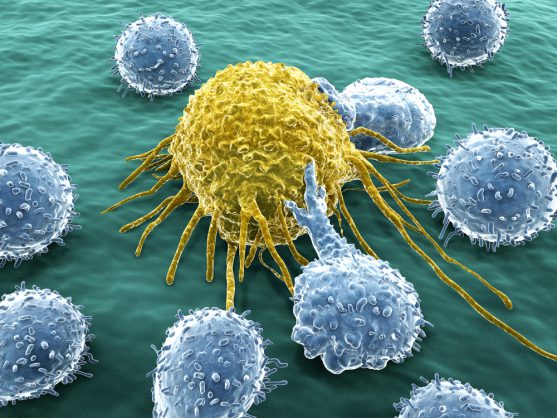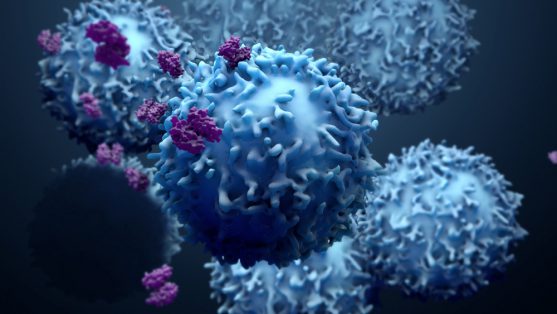Dr Suresh Babu, Medical Oncologist from Fortis Hospital, Bangalore, explains the link between immune system and cancer.
The human body has many organ systems that work in unison for optimal functioning of the body. Immune system is one such organ system that plays a vital role in protecting our body against disease or foreign bodies (pathogens). It is a complex network of cells, tissues and organs that actively fight against various infections and damaged cells.

If the immune system becomes dysfunctional, one becomes susceptible to invasion by the millions of microbes around us which cause infection and other kinds of illnesses.
What constitutes the immune system?
The defense system of our body is made up of bone marrow, thymus, lymphatic system or lymphoid organs, various immune cells, and skin and mucous membranes.
The major components of the immune system are as follows:
- Bone marrow: They are soft, spongy tissues inside the long and flat bones in our body and contain stem cells. Stem cells produce many kinds of cells, including the white blood cells (WBCs) which are the key players in our immune system.
- Thymus: It is a gland-like organ situated behind the breast bone above the heart. Thymus provides an environment for the T-lymphocytes to mature from its precursor cells.
- Lymphatic system: It is a complex network of lymph vessels, tissues, and organs. It defends the body against illnesses by producing disease-fighting cells known as lymphocytes.
- White blood cells (WBCs): WBCs or leukocytes originate from the bone marrow and become a part of the bloodstream to fight viruses, bacteria, and other foreign particles.
- Skin and Mucous membrane: These are the first-line defence that prevent penetration of pathogens inside the body.
The main types of WBCs are:
- Granulocytes: These include basophils, eosinophils and neutrophils. Granulocytes participate in the first step of immune response against tumours. They act as cytotoxic agents by releasing certain substances, such as inflammatory cytokines.
- Lymphocytes: They fight known infections and cancer cells by identifying them and initiating an immune response including directly destroying germs and cancerous cells or creating specific antibodies to fight against invading germs. Lymphocytes are of three types: B lymphocytes, T lymphocytes, and natural killer (NK) cells.
- Monocytes: These cells can travel through the blood to tissues in the body and transform into macrophages to destroy pathogens.
- Macrophages: These cells can locate and destroy bacteria, viruses, fungi, and parasites. Macrophages destroy and get rid of unwanted particles in the body through a process called phagocytosis.
Where do immune cells originate?
Immune cells are the collection of cells that defends the body from invaders. These cells have a unique ability of detecting and reacting against foreign organisms. These cells include:
- B cells (make specific antibodies)
- T-cells (helps to kill tumour cells and control immune responses)
- Nk cells (kills tumour cells by releasing certain chemicals)
- Dendritic cells (these are powerful-antigen presenting cells found in the bloodstream, skin, and other body tissues that detect an invading germ or growing cancer cells and convey this information to other immune cells to act on those specific germs or cancer cells)
All cells of the immune system originate from the bone marrow. Most of these cells have the potential to differentiate and mature into the different cells of the immune system. Some of the lymphocytes travel to the thymus, where they multiply and mature to become T-lymphocytes. Others remain in the bone marrow and become B cells.
After the T and B lymphocytes have matured in the thymus and bone marrow, they travel to the lymph nodes and spleen where they stay until an immune response is evoked.
What are the types of immune system?
The immune system can be categorised as follows:
-
Innate immunity
Also known as in-built immunity, the innate immune system is inherited from parents and passed on to the children. The innate immune response consists of physical, chemical and cellular defences against pathogens. They act immediately to defend the body from infection.
The cells involved in the innate immunity are natural killer cells, macrophages, neutrophils, dendritic cells, mast cells, basophils, eosinophils.
- Acquired immunity
Also known as adaptive immunity, the acquired immunity is developed following exposure to certain antigen. This immune response takes time to develop, after the first exposure to a new antigen (foreign body). Once the antigen is remembered, the responses to that antigen are quicker and more effective.
The unique components of acquired immunity are the lymphocytes (T cells and B cells). The lymphocytes secrete antibodies, highly specific protein molecules that bind to a specific pathogen. This specific immune response can kill cancer cells and can generate an immunologic memory of each tumor-related antigen.
What does an immune response look like?
Immune response is the specific reactivity induced by the immune system, when confronted by a foreign body or pathogens. Immune response primarily involves identifying pathogens and clearing the damaged and dying cells from the body.
When a pathogen gets into the body, the immune system reacts in 2 ways- humoral mediated immunity and cell mediated immunity.
1. Humoral (Antobody) mediated immunity
It is an antibody mediated immune response. Humoral immune response begins when an antibody on a B cell binds to an antigen. Activated B cells grow rapidly, producing plasma cells, which release antibodies into the bloodstream and destroy the antigen.
The memory B cells store information about the pathogen in order to provide future immunity. It is a primary defense against extracellular bacterial pathogens.
2. Cell mediated immunity:
Cell mediated immunity is mediated by antigen specific T- lymphocytes. T lymphocytes attack antigens directly and help control the immune response. T-cells release a chemical known as cytokines, which control the entire immune response.
Natural killer (NK) cells inactivate pathogens and the cytotoxic T cells kill the infected cells with or without antibodies. The cell-mediated immune system also plays a role in the rejection of organ transplants or graft tissue.
The immune system and cancer
Cells in our body grow, survive, and die as per the signals given by the genes. But, when this process is disturbed, cells may begin to grow abnormally and no longer respond to the signals. These cells grow and divide uncontrollably leading to cancer.
The term “cancer” describes the diseases in which certain cells divide at an uncontrollable rate and form a mass called tumor. These cells divide rapidly and invade other parts of the body.
In most cases, our immune system fails to recognize these cells as foreign bodies as cancer cells usually start out as normal cells. When recognized as abnormal cells, the immune system destroys those cells, but some cells may escape this, and silently keep growing to form cancer.
Some cancer cells may move out into the circulation and invade the surrounding tissues.
In immunodeficiency conditions, the immune surveillance may not be optimal enough to recognize these abnormal cancer cells, hence, no immune response is initiated against these. In people with co-morbid conditions such as diabetes, or stress, the body has chronic inflammation engaging the major immune cells, hence the cancer cells may go unnoticed.
Immunotherapy – How can the immune system be utilised for cancer therapy?

Immunotherapy is also called biologic therapy. Cancer immunotherapy aims to strengthen, and sustain the power of the immune system to fight cancer. The treatment uses certain drugs that can boost the body’s natural defences to recognize the cancer cells as abnormal and fight them.
Immunotherapy may work by:
- Stopping or slowing the growth of cancer cells and its spreading to other parts of the body
- Helping the immune system to recognize and destroy the cancer cells
Types of immunotherapy that are used to treat cancer include:
-
Immune checkpoint inhibitors
These drugs work by releasing “brakes” that keep T cells (a type of white blood cells and part of the immune system) from killing cancer cells. These drugs do not target the tumor directly. Instead, they interfere with the ability of cancer cells to avoid immune system attack.
Eg. Pembrolizumab, Nivolumab, etc.
-
T-cell transfer therapy
In this treatment, the natural ability of T cells to fight cancer is boosted to help attack and destroy the cancer cells. However, this treatment is still experimental.
-
Monoclonal antibodies
Here, artificial immune system proteins are designed to recognize and attack the cancer cells. It is also known as targeted therapy.
Eg: Bevacizumab, Cetuximab, etc.
-
Cancer vaccines
Some vaccines are used to treat cancer. These vaccines boost the immune system to recognize and destroy the abnormal cells.
Eg: Sipuleucel-T, BCG vaccine
-
Oncolytic virus therapy:
It is a new promising form of immunotherapy against cancer. This therapy involves usage of viruses to infect and destroy cancer cells without causing any harm to the normal cells.
Currently, the FDA has approved only one oncolytic virus therapy for cancer i.e., talimogene laherparepvec (t-vec) for melanoma.
What is the current status of immunotherapy?
Currently, immunotherapy is promising and is a rapidly developing mode of therapy. The US Food and Drug Administration (FDA) has approved a few immunotherapy drugs as a treatment option for many types of cancer, including lung cancer, melanomas, kidney cancers, bladder cancer, head and neck cancers and lymphomas. Many immunotherapy drug candidates are in the various research stages.



